-
PDF
- Split View
-
Views
-
Cite
Cite
Tim M Tugendhat, Robert Reischke, Björn Malte Schäfer, Statistical separation of weak gravitational lensing and intrinsic ellipticities based on galaxy colour information, Monthly Notices of the Royal Astronomical Society, Volume 494, Issue 2, May 2020, Pages 2969–2981, https://doi.org/10.1093/mnras/staa641
Close - Share Icon Share
ABSTRACT
Intrinsic alignments of galaxies are recognized as one of the most important systematic in weak lensing surveys on small angular scales. In this paper, we investigate ellipticity correlation functions that are measured separately on elliptical and spiral galaxies, for which we assume the generic alignment mechanisms based on tidal shearing and tidal torquing, respectively. Including morphological information allows to find linear combinations of measured ellipticity correlation functions that suppress the gravitational lensing signal completely or which show a strongly boosted gravitational lensing signal relative to intrinsic alignments. Specifically, we find that (i) intrinsic alignment spectra can be measured in a model-independent way at a significance of Σ ≃ 60 with a wide-angle tomographic survey such as Euclid’s, (ii) the underlying intrinsic alignment model parameters can be determined at per cent-level precision, (iii) this measurement is not impeded by misclassifying galaxies and assuming a wrong alignment model, (iv) parameter estimation from a cleaned weak lensing spectrum is possible with almost no bias, and (v) the misclassification would not strongly impact parameter estimation from the boosted weak lensing spectrum.
1 INTRODUCTION
The next generation of weak lensing surveys has the goal to measure correlations in the shapes of neighbouring galaxies over a wide range of angular scales and with resolution in redshift in order to investigate the properties of gravity through its influence on cosmic structure formation and in order to carry out a precision determination of cosmological parameters, investigate the properties of gravity on large scales, or determine details of dark energy models through their influence on cosmic structure formation. Whilst weak lensing surveys like Euclid or LSST provide exquisite statistical precision due to the vast amount of data, the control of systematics is the primary obstacle in the way of exploiting this information.
Weak cosmic shear refers to the correlated distortion of the cross-section of light bundles that reach us from distant galaxies (Mellier 1999; Bartelmann & Schneider 2001; Refregier 2003; Hoekstra & Jain 2008; Munshi et al. 2008; Kilbinger 2015). Using it as a cosmological probe, one primarily determines angular correlations in the ellipticities of galaxies, after subdividing the galaxy sample in redshift bins. Under the assumption of intrinsically uncorrelated shapes, the angular ellipticity correlation function measures lensing-efficiency weighted tidal shear correlations in the cosmic large-scale structure. These correlations carry information about the structure formation history as well as the expansion history of the Universe (Matilla et al. 2017), and do not rely on any assumption apart from the validity of a gravitational theory (Huterer 2002; Linder & Jenkins 2003; Amendola, Kunz & Sapone 2008; Bernstein 2009; Huterer 2010; Carron, Amara & Lilly 2011; Martinelli et al. 2011; Vanderveld et al. 2012).
Intrinsic alignments of galaxies mimic correlations in the shapes of neighbouring galaxies which would be naively contributed to gravitational lensing (for reviews, see Schaefer 2009; Joachimi et al. 2015; Kiessling et al. 2015; Kirk et al. 2015; Troxel & Ishak 2015). If unaccounted for, either by modelling or by mitigation, they would interfere with the parameter inference process and would lead to wrong conclusions about the cosmological model (Kirk, Bridle & Schneider 2010; Kirk et al. 2013, 2012; Laszlo et al. 2012; Capranico, Merkel & Schäfer 2013; Schaefer & Merkel 2017; Krause, Eifler & Blazek 2016; Tugendhat & Schaefer 2018). Whilst the exact mechanisms of galaxy alignment with the cosmic large-scale structure are not yet clear, tidal alignment models provide a physically motivated way to link the shapes of galaxies to the matter distribution on large scales. In the case of elliptical galaxies, for which the linear alignment model (also called tidal alignment model) might be applicable, one assumes a distortion of the galaxy ellipsoid by tidal gravitational forces, which act perturbatively on the galaxy and exert a shearing distortion (Hirata & Seljak 2004, 2010; Blazek, McQuinn & Seljak 2011; Blazek et al. 2019). In this case, the observed ellipticity is proportional to the tidal shear components perpendicular to the line of sight. In contrast, the alignment of spiral galaxies may be due to the quadratic alignment model, where the orientation of the galaxy is linked to the host halo angular momentum, which in turn is generated in the early stages of structure formation by tidal torquing (Crittenden et al. 2001; Natarajan et al. 2001; Mackey, White & Kamionkowski 2002). As an orientation effect, the alignment of spiral galaxies would not reflect the magnitude of tidal fields but would only depend on their orientation. Applying the models in the strictest sense would result in predicting a non-vanishing cross-correlation between the gravitational lensing effect and the linear tidal alignment of elliptical galaxies.
Our study is motivated by the fact that the distortion of galaxy ellipticities due to gravitational lensing should be universal and not depend on galaxy type. In this case, one should be able to make use of morphological information in order to find linear combinations of ellipticity maps where the intrinsic alignment signal is up- or down-weighted relative to the gravitational lensing signal. We will investigate the usability of ellipticity spectra with weighted relative contributions from gravitational lensing and from intrinsic alignments, with the purpose of cosmological inference from weak lensing with suppressed IA-induced biases as well as for investigating alignment signals with a suppressed weak gravitational lensing effect, that would otherwise dominate ellipticity correlations.
The fiducial cosmological model is a spatially flat ΛCDM cosmology motivated by the Planck-results (Planck Collaboration et al. 2016), with specific parameter choices Ωm = 0.32, ns = 0.96, σ8 = 0.83, and h = 0.68, with a constant dark energy equation of state parameter of |$w$| = −1.0. We adopt the summation convention and orient coordinate systems in such a way that the |$z$|-axis points along the line of sight. We carry out all computations and statistical estimates for the Euclid missions, but all statements would be applicable in a similar way to other weak lensing surveys with similar survey depths. After a summary of cosmology in Section 2, we review weak gravitational lensing and intrinsic alignments in Section 3. We introduce our method and demonstrate the separation technique in Section 4 and summarize and discuss our results in Section 5.
2 COSMOLOGY
3 WEAK GRAVITATIONAL LENSING AND INTRINSIC ALIGNMENTS
3.1 Gravitational tidal fields and their statistics
3.2 Weak gravitational lensing
3.3 Alignments of spiral galaxies
Fig. 1 gives a visual impression of alignments in the quadratic, angular momentum-based alignment model. From a realization of a Gaussian random density field |$\delta (\boldsymbol {x})$| from the CDM-spectrum P(k), we computed the traceless, unit-normalized tidal shear |$\hat{\Phi }_{\alpha \beta }$|, which is used to determine the variance of the distribution |$p(\hat{L}_\alpha |\hat{\Phi }_{\alpha \beta })$|. Angular momenta are drawn at random locations that fix the orientation of the galactic discs. The amount of correlation in the orientation of the galactic discs corresponds determined from the realization corresponds to the theoretically computed correlation function. Ellipticity correlations between spiral galaxies are rather short-ranged, with a typical correlation length of about 1 Mpc h−1 (Schaefer & Merkel 2012), which makes them a small-scale phenomenon at angular scales of ℓ ≃ 103 for Gpc-scale surveys.
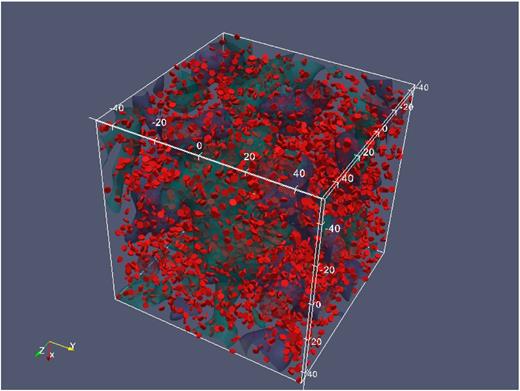
A realization of the cosmic matter distribution as a Gaussian random field in a cube of the side length 100 Mpc h−1. The blue and green surfaces are ±1σ contours of the density field, and the orientation of the galactic discs (in red) follow from a quadratic, angular momentum–based alignment model.
3.4 Alignments of elliptical galaxies
The alignment model parameters A and D are chosen to have values of A = 0.25 from numerical simulations of angular momentum generation in haloes, and D = 9.5 × 10−5c2 from CFHTLenS-data, respectively. Whilst A is effectively a geometric, dimensionless parameter, D links the dimensionless ellipticity to the tidal shear field. For a more detailed discussion of this relationship including the scaling with mass, we refer to Piras et al. (2018) and Tugendhat & Schaefer (2018). Whilst there is no definitive measurement of ellipticity correlations of spiral galaxies, the case is notably different for elliptical galaxies (Mandelbaum et al. 2006, 2011; Singh, Mandelbaum & More 2015).
3.5 Cross-alignments between intrinsic shapes and lensing
For spiral galaxies, there exist no GI-type terms due to Wick’s theorem, because those terms would be proportional to a third moment of the tidal shear field. In contrast, there will be a non-vanishing cross-correlation between lensing and the intrinsic alignment of elliptical galaxies. We would like to point out that these cross-correlations, |$C^{\mathrm{e},GI}_{ij}(\ell)$|, have to be symmetrized with respect to the bin numbers. Naturally, the more distant galaxy is lensed, whereas the closer galaxy is intrinsically aligned whilst the inverse is not possible. Statistical isotropy forces the covariance matrix to be symmetrical however (Tugendhat & Schaefer 2018). We scale the cross-spectra |$C^{\mathrm{e},GI}_{ij}(\ell)$| with the number ne(ne + ns) = nen of pairs involving at least one elliptical galaxy.
It is worth pointing out that there is a straightforward physical difference between the weak lensing and intrinsic alignments. As weak lensing is an integrated effect, there will be non-zero cross-correlations between different tomographic bins, whereas intrinsic alignments will, due to their locality, only show correlations within the same bin. This can already be used as a method of discrimination between II- and GG spectra (Bernstein & Jain 2004; Huterer & White 2005), but will not get rid of the GI contribution.
3.6 Shape correlations in a weak lensing survey
Linking the correlations of the observable ellipticity ϵ to the tidal shear fields allows to express correlations in ϵ in terms of correlations in |$\partial ^2_{\alpha \beta }\Phi$|. A suitable Limber projection with the redshift distribution n(|$z$|)d|$z$|, whilst introducing a binning allows us to compute angular correlation functions and in the next step, to obtain tomographic angular E-mode spectra |$C^{\mathrm{s},II}_{ij}(\ell)$|, |$C^{\mathrm{e},II}_{ij}(\ell)$| and lastly |$C^{\mathrm{e},GI}_{ij}(\ell)$|, which we can compare to the tomographic weak lensing spectrum |$C^\gamma _{ij}(\ell)$| (Hu 1999; Hu & White 2001). Due to the locality of intrinsic alignments, the two II-spectra are ∝δij, whilst the GI-spectrum or the weak lensing spectrum do not possess this property (Hirata & Seljak 2004). Central to our investigation will be the linear dependence of the ellipticity with tidal shear field for gravitational lensing and for the intrinsic alignment of elliptical galaxies, whilst the shapes of spiral galaxies depend on squares of the tidal shear. For non-tomographic, three-dimensional weak lensing surveys, the effects of intrinsic alignments are physically identical and can be studied analogously (Merkel & Schaefer 2013).
Fig. 2 shows the expected E-mode spectra for a ΛCDM-cosmology with a conventional choice of the alignment parameters A and D for tomography with nbin = 3 bins with Euclid, resulting from a Limber projection (Limber 1954) and subsequent Fourier transform. For a reasonably deep lensing survey such as Euclid’s, lensing-induced ellipticity correlations dominate over intrinsic alignments. The IA contribution on large angular scales is caused by elliptical galaxies following the tidal shearing model, whereas on small scales the contribution from spiral galaxies, which is described by the tidal torquing model, is most important. Over a wide range of angular scales, the negative cross-correlation between gravitational lensing and intrinsic alignments shapes the ellipticity spectrum. It is notable that the shapes of elliptical galaxies and lensing measure tidal field components perpendicular to the line of sight and are proportional to the magnitude of the tidal shears, but that in contrast spiral galaxies reflect with their shapes the tidal field orientation including line of sight-components. For details on the derivation of angular shape correlation functions and E/B-mode ellipticity spectra, we refer to Capranico et al. (2013), Schaefer & Merkel (2017), and Tugendhat & Schaefer (2018).
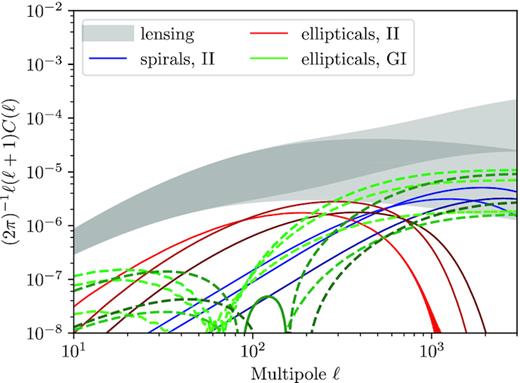
Contributions to the ellipticity correlations by weak gravitational lensing |$C^\gamma _{ij}(\ell)$|. The number of tomography bins is nbin = 3, and negative contributions are depicted in dashed lines. The grey bands show the upper and lower limits of the six weak lensing spectra possible from 3-bin tomography; separately for linear structure formation (lower band) and non-linear structure formation (upper band), the linear lensing falls off at large ℓ. The IA contributions are |$C^{\mathrm{e},GI}_{ij}(\ell)$| (green), |$C^{\mathrm{s},II}_{ij}(\ell)$| (blue), and |$C^{\mathrm{e},II}_{ij}(\ell)$| (red). Here, we also show all possible bin pairings, the three autocorrelations for the II-part, as well as all six possible combinations for the GI-part. Darker colour indicates higher bin numbers ij.
4 SEPARATION BETWEEN WEAK LENSING AND GALAXY ALIGNMENTS
4.1 Idea and formalism
Weak gravitational lensing and intrinsic alignments of galaxies are tidal gravitational effects of the cosmic large-scale structure, but the details of how the observed shape of a galaxy is influenced by the tidal field |$\partial ^2_{ij}\Phi$| generated by the large-scale structure depends on the interaction mechanism: gravitational lensing is universal and operates on all galaxy shapes in an identical way. For the intrinsic alignment contributions, we assume that elliptical galaxies change their shape in proportion to the tidal gravitational field according to the tidal shearing model and that the shape of spiral galaxies is an orientation effect that depends on the squared, unit-normalized tidal field, as stipulated by the tidal torquing model. The dependences on the linear and squared tidal shear field have the important consequence that there is no cross-correlation between lensing and the intrinsic shape of spiral galaxies, |$\langle \gamma \epsilon _\mathrm{s}^\prime \rangle = 0$| and neither between the shapes of spiral and elliptical galaxies, |$\langle \epsilon _\mathrm{s}\epsilon _\mathrm{e}^\prime \rangle = 0$|, if the tidal shear field follows Gaussian statistics. In this case, the two correlation functions would be proportional to a third moment of a symmetric distribution, which makes them vanish. In contrast, there will be a non-zero cross-correlation between the intrinsic shapes of elliptical galaxies and weak lensing, |$\langle \gamma \epsilon _\mathrm{e}^\prime \rangle \ne 0$|, which is usually dubbed GI alignment. These model choices are consistent with Tugendhat & Schaefer (2018), where the implications of such a physically motivated mixed model for the two overwhelmingly contributing morphologies are studied. Other model choices, such as the closely related Blazek et al. (2019), would not invalidate this method. Although correlations between the two morphologies would contaminate the isolated gravitational lensing signal, a separation of galaxy types using colour information would still be feasible. Using multiple models for each galaxy type would make the calculation more complex as well, but can be done in principle. We have chosen to use the aforementioned models for the two morphologies because we believe them to be a physically well-motivated choice and thus being the major contributor to the IA signal. A more complex model, for example additional linear term dependence of spirals at some scales, would amount to a misclassification of galaxy types in our ansatz, which we discuss in detail. Furthermore, an additional dependence of the spiral model on the amplitude of the tidal field would change the amplitude of the corresponding part of the IA signal, however it would not affect the points where both IA signals disappear. Superficially not unlike a multitracer method (such as used in e.g. Leonard & Mandelbaum 2018), our formalism allows for a certain flexibility for which signals to boost or suppress, respectively. For example, the lensing signal can be slightly enhanced over intrinsic alignments or eliminated completely depending only on the choice of a free parameter.
But if one now focuses on the statistical property of a single field, for instance ϵ+,i, it is possible to influence the relative contribution of lensing and the intrinsic alignment terms by a suitable choice of α. Of course, this can be trivially achieved by setting α = 0, in which case there are only spiral galaxies in the measurement whose shape correlations would be described by |$C^\gamma _{ij}(\ell) + C^{\mathrm{s},II}_{ij}(\ell)$|, or by choosing α = π/2, which eliminates all galaxies apart from the elliptical ones with the shape correlation |$C^\gamma _{ij}(\ell) + 2C^{\mathrm{e},GI}_{ij}(\ell) + C^{\mathrm{e},II}_{ij}(\ell)$|.
Peculiarly, these factors vanish always at the same choice of α that also eliminates |$C^{\mathrm{s},II}_{ij}$|, e.g. α = |$\pi$|/2 for q = 0.5. In general, thus, it is always possible to remove all spiral alignment contributions at once using this method – at the price of statistically diminishing the lensing signal and boosting the relative contribution of elliptical galaxies’ alignment.
The aforementioned point that eliminates lensing completely – meaning choosing α to be 3|$\pi$|/4 for q = 0.5 – still holds as well. The spiral GI contributions vanish here alongside the elliptical GI signal, whilst a spiral-elliptical cross-alignment would remain, albeit with a negative sign.
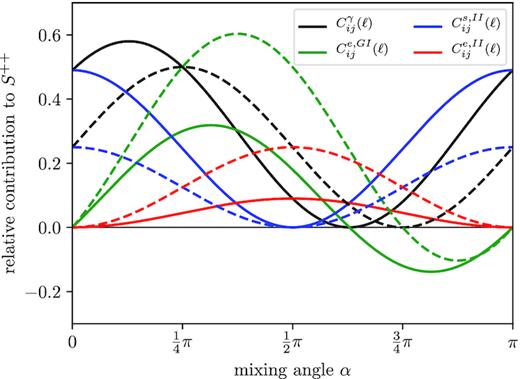
Relative contributions of weak lensing and intrinsic alignments to the spectrum |$C^{++}_{ij}(\ell)$| as a function of mixing angle α: weak gravitational lensing |$C^\gamma _{ij}(\ell)$| (black), |$C^{\mathrm{e},GI}_{ij}(\ell)$| (green), |$C^{\mathrm{s},II}_{ij}(\ell)$| (red line), and |$C^{\mathrm{e},II}_{ij}(\ell)$| (blue). Dashed lines correspond to a q = 0.5, whilst solid lines have q = 0.7. At α = 3|$\pi$|/4, the contributions involving weak lensing vanish for ns = ne.
4.2 Misclassification
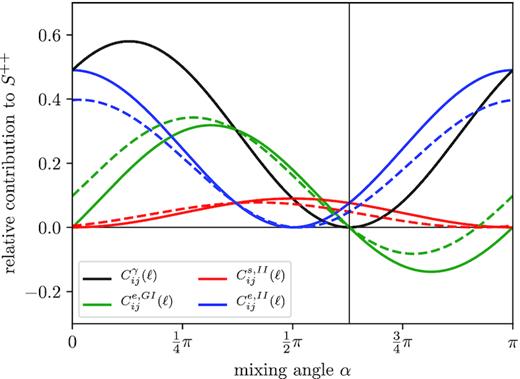
Relative contributions of weak lensing and intrinsic alignments to the spectrum |$C^{++}_{ij}(\ell)$| as a function of mixing angle α. The colour scheme is the same as in Fig. 3. Here, q = 0.7 for both dashed and solid curves. However, here, dashed curves have a misclassification rate p(b|r) = p(r|b) = 0.1, whilst the solid curves represent all galaxies identified correctly.
4.3 Separating out intrinsic alignments
Fig. 5 shows in detail the attainable significance Σ for the intrinsic alignment contribution, both cumulatively and differentially, as a function of multipole moment ℓ and for different number of tomographic bins. Clearly, intrinsic alignments generate a significant signal in Euclid’s survey and the magnitude of the alignments, both for spiral and elliptical galaxies, allows a determination of parameters of the alignment model at percent precision. It is also interesting to see that most of the signal is picked up at relatively low multipoles, showing that the assumption of Gaussian random fields can indeed be used. The reason for this is that the intrinsic alignment signal only probes the autocorrelation of different bins, and thus the shape-noise dominates the high multipole moments, which becomes dominant earlier compared to the II alignments due to their lower amplitude. Tomography is a large factor in attaining a high signal-to-noise ratio and therefore, in investigating intrinsic alignment models, as Σ increases from 35 with 2 bins to over 60 with 7 bins. These numbers are in agreement with forecasts on alignment amplitudes: As the alignment signal is proportional to A or D, the signal-to-noise ratio corresponds to the inverse statistical error on these pre-factors, such that one should achieve per cent-level precision from a measurement yielding 100σ of statistical significance. It is remarkable that this level can be reached even if one considers a combination of cosmological probe and a complex cosmological model (Kitching, Heavens & Das 2015; Merkel & Schaefer 2017). Fig. 5 shows in detail the attainable significance Σ for the intrinsic alignment contribution, both cumulatively and differentially, as a function of multipole moment ℓ and for different number of tomographic bins. Clearly, intrinsic alignments generate a significant signal in Euclid’s survey and the magnitude of the alignments, both for spiral and elliptical galaxies, allows a determination of parameters of the alignment model at percent precision. It is also interesting to see that most of the signal is picked up at relatively low multipoles, showing that the assumption of Gaussian random fields can indeed be used. The reason for this is that the II-part of intrinsic alignment signal only probes the autocorrelation of different bins (since IA is a small scale effect) and thus the shape-noise dominates the high multipole moments, which becomes dominant earlier compared to the II alignments due to their lower amplitude. Tomography is a large factor in attaining a high signal-to-noise ratio and therefore, in investigating intrinsic alignment models, as Σ increases from 35 with 2 bins to over 60 with 7 bins. These numbers are in agreement with forecasts for Euclid-like surveys on alignment amplitudes (e.g. Tugendhat & Schaefer 2018). As the alignment signal is proportional to A or D, the signal-to-noise ratio corresponds to the inverse statistical error on these pre-factors, such that one should achieve per cent-level precision from a measurement yielding 100σ of statistical significance. It is remarkable that this level can be reached even if one considers a combination of cosmological probe and a complex cosmological model (Kitching et al. 2015; Merkel & Schaefer 2017).
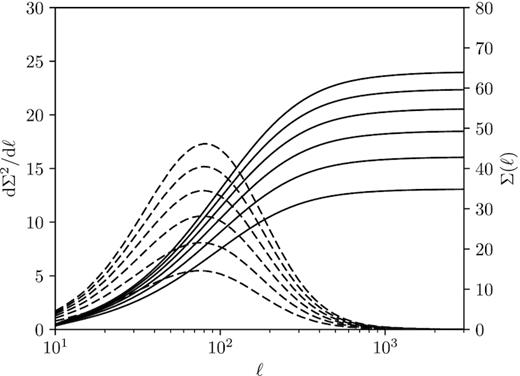
Cumulative Σ(ℓ) (solid lines) and differential signal-to-noise ratio dΣ/dℓ (dashed lines) for the measurement of the intrinsic alignment spectra |$C^{\mathrm{s},II}_{ij}(\ell) + C^{\mathrm{e},II}_{ij}(\ell)$| as defined by equation (45) for a tomographic ellipticity measurement for nbin = 2…7 bins for a survey like Euclid’s.
We quantify the difference between the ideal spectra and the one containing wrongly classified galaxies with the average 〈Δχ2〉 between the two models. For that purpose, we identify the |$C^{++}_{ij}(\ell)$| contribution from the rotated covariance matrix Ct(ℓ) and the corresponding |$X^{++}_{ij}(\ell)$| from the rotated covariance matrix Cf(ℓ) including shape correlations of wrongly identified galaxies, by setting α = 3|$\pi$|/4.
First of all, we expect the obtainable Σ2(ℓ) to be smaller in the case where galaxies have been identified wrongly, since the relative contribution is smaller as it can be seen in Fig. 4. This will lead to a difference 〈Δχ2〉 between the true model and the model containing wrongly identified galaxies by expressing the difference in the spectra in units of the cosmic variance, which we show in Fig. 6. At ℓ ≳ 200, the difference in χ2 continues to grow steadily due to the difference in the noise contributions, as the noise is dependent on the galaxy counts, which naturally differ if there is a misclassification of galaxy types. Furthermore, the loss of Gaussianity in the correlations at larger ℓ will lead to complicated cross-correlations between the alignment effects that have not been included in the calculation of 〈Δχ2〉 or indeed in the considerations for a misclassified signal Sf(ℓ) (cf. equation 43).
![Difference 〈Δχ2〉 between the covariances C++(ℓ) (where all galaxies are correctly identified) and X++(ℓ) [with assumed misidentification rates of p(b|r) = p(r|b) = 0.1] as a function of multipole ℓ for nbin = 2…7 tomographic spectra.](https://oup.silverchair-cdn.com/oup/backfile/Content_public/Journal/mnras/494/2/10.1093_mnras_staa641/1/m_staa641fig6.jpeg?Expires=1750808495&Signature=S7L2uw-393e~rJKtNU02DWyWHrwo7NMkx0sbihEPIC41s2eHhjygl4RSYQ-ajJZKuc-EC5GnU7qfV76CRrDf4tLIOezAyKd3cYkFZxaE576rzAWzDIQXRRYlsHEjqJsW9aS1lD8ht04wGae2LMZixjZvZBFo~JTpRZv8WjBHszoz33odfKB3t4k1ItBeCdG3ffvGAJhHIS3~KGWzhjd6ob9Ms~4igUt9ZvIzCBnv~K4tigGqOsIx41bSugcGX7SIDJ6AvF2IX2kIfSzVRpOOnJTGWftvc87G8MrpsKQQO4FxQhtb48c-cQVyL9r6cU58xw5Z9lTj7V64GVvPiFNOGw__&Key-Pair-Id=APKAIE5G5CRDK6RD3PGA)
Difference 〈Δχ2〉 between the covariances C++(ℓ) (where all galaxies are correctly identified) and X++(ℓ) [with assumed misidentification rates of p(b|r) = p(r|b) = 0.1] as a function of multipole ℓ for nbin = 2…7 tomographic spectra.
4.4 Boosting the weak lensing spectrum
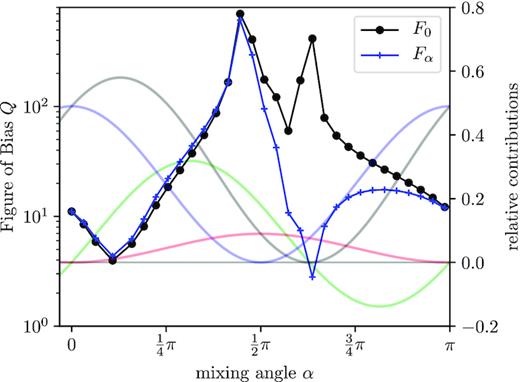
Total bias Q(α) in units of the statistical error, Q2 = ∑μνFμνδμδν as a function of the mixing angle α, where the minimum indicates the value of α that is able to yield the smallest possible systematic error corresponding to the cleanest weak lensing spectrum. F0 (black) corresponds to a derivative at α = |$\pi$|/4, whereas Fα in blue shows the same with derivative taken at the corresponding α. The translucent lines in the background are taken from Fig. 3 as a guideline, where IAs vanish and where they dominate.
Typically, relative contributions of the order of 10 per cent of the intrinsic alignment signal to weak lensing cause figures of bias Q of the order up to a few hundred, which can be controlled by our technique. It would be interesting to propagate intrinsic alignments with other systematic effects through the parameter estimation process as outlined by Cardone et al. (2014).
Lastly, we aim to constrain the parameters of the alignment models for the two types of galaxies, specifically the alignment amplitude D that describes the elasticity of elliptical galaxies and the amplitude A which describes the magnitude A of the misalignment between tidal shear and inertia which is responsible for angular momentum generation in spiral galaxies. If one suppresses lensing, including GI alignment, Fig. 8 suggests that both alignment parameters can be constrained at the percent level with the Euclid data set without having to worry about biases due to gravitational lensing. These numbers result from a Fisher-matrix analysis for the parameters A and D with a choice of α that eliminates lensing, and fitting the corresponding intrinsic ellipticity spectra to the remainder, whilst taking account of cosmic variance and shape noise contributions and keeping all cosmological parameters fixed to their fiducial values.
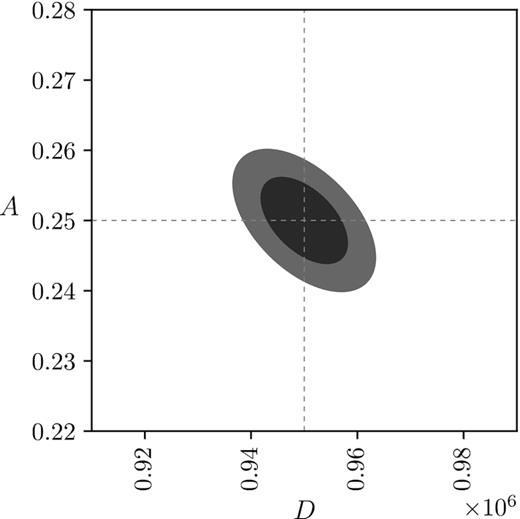
Fisher constraints of the model parameters A and D for the quadratic and linear alignment models, respectively, for nbin = 7 in Euclid.
5 SUMMARY
Subject of this investigation was the use of colour information to differentiate between intrinsic ellipticity correlations of galaxies and the weak gravitational lensing signal. We operate under the assumptions that (i) the large-scale structure follows Gaussian statistics on large scales, (ii) intrinsic shapes of elliptical galaxies follows the linear tidal shearing model, (iii) intrinsic shapes of spiral galaxies follows the quadratic tidal torquing model, (iv) gravitational lensing is universal and linear in the tidal shear, (v) it is possible to classify galaxies on the basis of colour information to obey one of the two alignment mechanisms, and (vi) shape and redshift measurements for the cosmic shear analysis are under control. Based on the fact that lensing is universal and affects all galaxy shapes in an identical way irrespective of galaxy type it is possible to find linear combinations of ellipticity fields measured for spiral and elliptical galaxies that do not contain any lensing signal and only retain shape correlations due to intrinsic alignments. It should be emphasized that this is possible without any assumption about the details of gravitational lensing or of the intrinsic alignment models. Intrinsic alignments that have been separated in this way from the lensing signal, can be measured on the basis of Euclid’s weak lensing data set with a high statistical significance. The subject of this investigation was the use of colour information to differentiate between intrinsic ellipticity correlations of galaxies and the weak gravitational lensing signal. We operate under the assumptions that (i) the large-scale structure follows Gaussian statistics on large scales, (ii) intrinsic shapes of elliptical galaxies follows the linear tidal shearing model, (iii) intrinsic shapes of spiral galaxies follows the quadratic tidal torquing model, (iv) gravitational lensing is universal and linear in the tidal shear, and (v) it is possible to classify galaxies on the basis of colour information to obey one of the two alignment mechanisms. Based on the fact that lensing is universal and affects all galaxy shapes in an identical way irrespective of galaxy type it is possible to find linear combinations of ellipticity fields measured for spiral and elliptical galaxies that do not contain any lensing signal and only retain shape correlations due to intrinsic alignments. It should be emphasized that this is possible without any assumption about the details of gravitational lensing or of the intrinsic alignment models. Intrinsic alignments that have been separated in this way from the lensing signal can be measured on the basis of Euclid’s weak lensing data set with a high statistical significance:
As alignment models, we consider tidal shearing for elliptical galaxies and tidal torquing for spiral galaxies and compute the resulting tomographic angular ellipticity spectra including the non-zero cross-correlation between the shape of elliptical galaxies and weak lensing. Both models have a single free parameter each, which we determined from weak lensing data and from numerical simulations, respectively. In analysing data, we showed that Euclid will allow their measurement at a level of a few per cent. In that, we assume constant and scale-independent alignment parameters. The forecasted statistical precision would allow the investigation of alignment models with Euclid’s weak lensing data set and shed light on (i) the average misalignment of angular momenta with tidal shear fields and (ii) the reaction of a virialized structure to external tidal shear fields.
We develop a statistical method that allows the separation between weak lensing and both alignment types on the basis of colour or morphological information. We assume that elliptical galaxies, if they are correctly identified, obey exclusively linear tidal shearing as their alignment mechanism, whilst spiral galaxies are described by the quadratic tidal torquing model. Gravitational lensing is universal, as it affects the shapes of spiral and elliptical galaxies identically.
All mitigation and suppression techniques have in common that statistical precision is traded for systematical accuracy, and our method is no exception. Starting from shape catalogues measured for different types of galaxies, it is possible to find linear combinations of the shape measurements that contain no spiral alignment, no elliptical alignment, or no gravitational lensing, including in this case no lensing-alignment cross-correlation either. With that in mind, it is possible to find a linear combination that eliminates lensing from the data set and leaves only contributions to the shape correlations that differ between elliptical and spiral galaxies, i.e. intrinsic alignments. Taking these cleaned correlation functions, they allow a measurement of the intrinsic alignment signal without any model assumptions to ∼60σ of statistical precision for a tomographic survey such as Euclid’s. For other surveys, such as LSST, we expect a significantly lower contributions of IA, since they are (a) deeper and (b) less wide than Euclid. The effect from (a) is that the survey gathers information from redshifts where IA is much lower, as structure formation is less developed at those stages as well as the lensing efficiency dominates even more strongly. From (b) we expect a lower statistical significance, as there is more shot noise, which also washes out IA contributions. Therefore, only a survey that clearly makes out IA contamination to a significant amount is relevant for this method.
An independent verification of the validity of the separation of lensing and IA contributions could possibly be done by measuring B-mode spectra and comparing those to the predicted B-modes (if any) of the underlying intrinsic alignment models. This is not particular to our choice of models but can in principle be done for any assumption of IA models, especially to verify or improve the model parameter measurement.
Suppression of intrinsic alignment contributions for achieving a bias-free weak lensing measurement is possible, but not completely. With an optimized choice of the mixing angle α one can reduce the systematical bias in units of the statistical error by a large margin, and we show that biases are reduced to amount to typically a few σ for the full ΛCDM parameter set. We quantify the magnitude of the systematic error in units of the statistical error by the figure of bias Q2 = ∑μνFμνδμδν, which takes care of the orientation of the systematic error δμ with respect to the statistical degeneracies encoded in the Fisher matrix Fμν. Incidentally, Q2/2 corresponds to the Kullback–Leibler divergence between the biased and unbiased likelihood |$\mathcal {L}$|.
Misclassification i.e. non-zero probabilities p(r|b) and p(b|r) do not affect our conclusions strongly even for very high probabilities of misclassification of the order of 10 per cent. This generous limit for misclassifications is also chosen to show that additional IA mechanisms that can be treated as misclassifications would not change our results meaningfully. We quantify this by computing the difference between the resulting covariance in terms of the χ2-statistic, where instrumental noise and cosmic variance are present as noise sources. At accessible scales below a few hundred in ℓ, i.e. before the instrumental noise dominates, the integrated Δχ2 is a few ten, which, given the sensitivity of a weak lensing survey with respect to parameters such as σ8 or Ωm, would give rise to biases. We estimate that the misidentification probabilities would need to be controlled to well below 10 per cent for the biases not to exceed 1σ in terms of the statistical error in this case.
Precursing to the work presented here, there are quite a few other mitigation techniques. Catelan et al. (2001) proposed tomographic methods to reduce the II-alignment signal by avoiding spatially close galaxies. This exploits the large correlation length of the weak lensing signal, compared to the intrinsic alignment signal. The drawback of this method is the increased cosmic variance and shape noise and thus a loss of statistical power. This technique was used by several authors (e.g. King & Schneider 2002; Heymans & Heavens 2003; Heymans et al. 2004; Takada & White 2004; Heymans et al. 2013; Joachimi et al. 2013a).
Another method is to construct a different weighting of the cosmic shear signal to reduce the contamination by GI alignments. This nulling technique was discussed by Huterer & White (2005) and Joachimi & Schneider (2010). It has been proposed as well to null and boost magnification (Heavens & Joachimi 2011; Schneider 2014), which can also bias the parameter inference process. Alternatively, one can also use self-calibration techniques, making use of additional information and the cross-correlation of cosmic shear and galaxy clustering, as well as galaxy clustering autocorrelations, which has been used by Bernstein & Jain (2004), Bernstein (2009), Zhang (2010) or use the large difference in the amplitudes of E- and B-mode spectra of intrinsic alignments and weak lensing (Crittenden et al. 2002; Schaefer & Merkel 2017). Our method could as well be extended bispectra of the ellipticity field (Shi, Joachimi & Schneider 2010; Merkel & Schaefer 2014; Larsen & Challinor 2016), either in order to make the method less dependent on the assumption of Gaussianity of the tidal shear field or by relaxing on the relationship that the observable shape depends on the tidal shear field in a linear or quadratic way. Taking this idea further, it would be very interesting to see if other cross-correlation measurements, for instance correlations between the CMB-lensing field and galaxy shapes at higher redshifts than the ones considered here, would constraint alignment processes as well (Hall & Taylor 2014).
In summary, there is a wealth of information that helps to differentiate intrinsic alignments and weak lensing, even without sacrificing statistical precision for accuracy. Whilst our investigation assumes that it is possible to assign an alignment model to a given galaxy on the basis of its colour (or other morphological information), inclusion of higher order statistics, E/B-mode decomposition or redshift weighting scheme should enable a thorough understanding of shape correlations. We would consider the possibility of eliminating the lensing signal including the GI terms from the ellipticity correlation through a suitable choice of α very interesting for the model-independent detection of intrinsic alignments.
ACKNOWLEDGEMENTS
TMT acknowledges a doctoral fellowship from Astronomisches Rechen-Institut in Heidelberg and RFR acknowledges funding from the Israel Science Foundation (grant nos 1395/16 and 255/18). BMS would like to thank the University of Auckland, in particular S. Hotchkiss and R. Easthers for their hospitality during the early stages of this project, and A. Nusser and V. Desjacques for their hospitality at the Technion in Haifa during the final writeup. We would like to thank H. Hildebrandt for a suggestion for values of p(b|r) and p(r|b). We would furthermore like to thank the anonymous referee for their invaluable corrections, suggestions for improvement, and patience.



